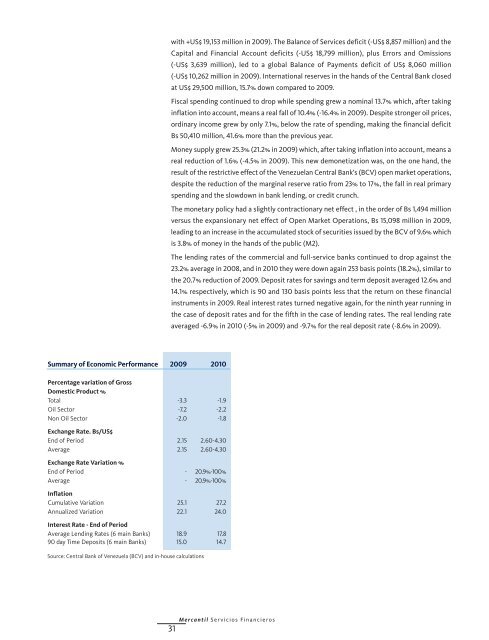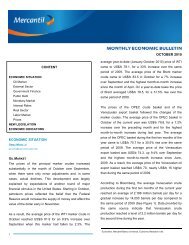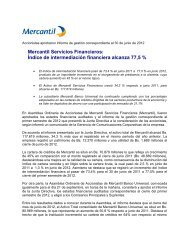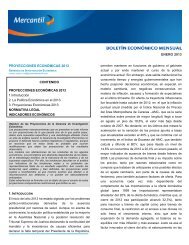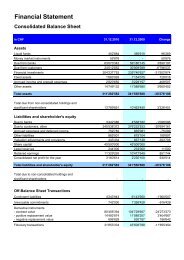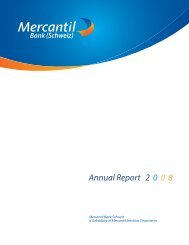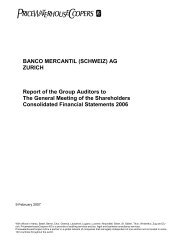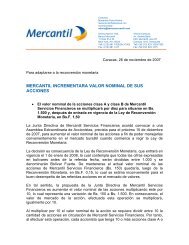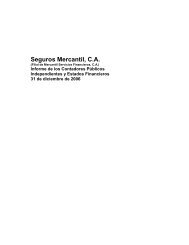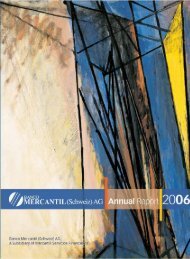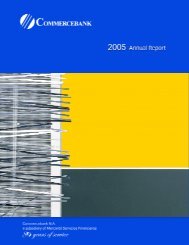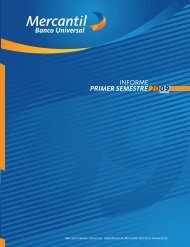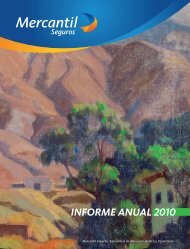ANNUAL REPORT 2010
ANNUAL REPORT 2010
ANNUAL REPORT 2010
You also want an ePaper? Increase the reach of your titles
YUMPU automatically turns print PDFs into web optimized ePapers that Google loves.
Summary of Economic Performance 2009 <strong>2010</strong><br />
Percentage variation of Gross<br />
Domestic Product %<br />
Total -3.3 -1.9<br />
Oil Sector -7.2 -2.2<br />
Non Oil Sector -2.0 -1.8<br />
Exchange Rate. Bs/US$<br />
End of Period 2.15 2.60-4.30<br />
Average 2.15 2.60-4.30<br />
Exchange Rate Variation %<br />
End of Period - 20.9%-100%<br />
Average - 20.9%-100%<br />
Inflation<br />
Cumulative Variation 25.1 27.2<br />
Annualized Variation 22.1 24.0<br />
Interest Rate - End of Period<br />
Average Lending Rates (6 main Banks) 18.9 17.8<br />
90 day Time Deposits (6 main Banks) 15.0 14.7<br />
Source: Central Bank of Venezuela (BCV) and in-house calculations<br />
with +US$ 19,153 million in 2009). The Balance of Services deficit (-US$ 8,857 million) and the<br />
Capital and Financial Account deficits (-US$ 18,799 million), plus Errors and Omissions<br />
(-US$ 3,639 million), led to a global Balance of Payments deficit of US$ 8,060 million<br />
(-US$ 10,262 million in 2009). International reserves in the hands of the Central Bank closed<br />
at US$ 29,500 million, 15.7% down compared to 2009.<br />
Fiscal spending continued to drop while spending grew a nominal 13.7% which, after taking<br />
inflation into account, means a real fall of 10.4% (-16.4% in 2009). Despite stronger oil prices,<br />
ordinary income grew by only 7.1%, below the rate of spending, making the financial deficit<br />
Bs 50,410 million, 41.6% more than the previous year.<br />
Money supply grew 25.3% (21.2% in 2009) which, after taking inflation into account, means a<br />
real reduction of 1.6% (-4.5% in 2009). This new demonetization was, on the one hand, the<br />
result of the restrictive effect of the Venezuelan Central Bank’s (BCV) open market operations,<br />
despite the reduction of the marginal reserve ratio from 23% to 17%, the fall in real primary<br />
spending and the slowdown in bank lending, or credit crunch.<br />
The monetary policy had a slightly contractionary net effect , in the order of Bs 1,494 million<br />
versus the expansionary net effect of Open Market Operations, Bs 15,098 million in 2009,<br />
leading to an increase in the accumulated stock of securities issued by the BCV of 9.6% which<br />
is 3.8% of money in the hands of the public (M2).<br />
The lending rates of the commercial and full-service banks continued to drop against the<br />
23.2% average in 2008, and in <strong>2010</strong> they were down again 253 basis points (18.2%), similar to<br />
the 20.7% reduction of 2009. Deposit rates for savings and term deposit averaged 12.6% and<br />
14.1% respectively, which is 90 and 130 basis points less that the return on these financial<br />
instruments in 2009. Real interest rates turned negative again, for the ninth year running in<br />
the case of deposit rates and for the fifth in the case of lending rates. The real lending rate<br />
averaged -6.9% in <strong>2010</strong> (-5% in 2009) and -9.7% for the real deposit rate (-8.6% in 2009).<br />
Mercantil Servicios Financieros<br />
31


